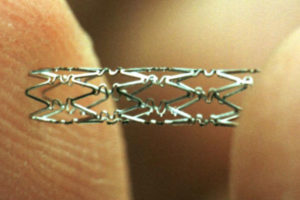
The results of NORSTENT (Norwegian coronary stent trial) indicate that second-generation drug-eluting stents do not significantly reduce the long-term risk of all-cause mortality compared with contemporary bare metal stents. However, both the NORSTENT investigators and those commenting on the study say that drug-eluting stents—because they are associated with a reduced risk of revascularisation—are still the preferred stent for percutaneous coronary intervention (PCI).
Presenting the data at the 2016 European Society of Cardiology (ESC) congress (27–31 August, Rome, Italy), Kaare Harald Bønaa (Clinic for Heart Disease, St Olav’s University Hospital, Trondheim, Norway) reported that the evidence that supports the use of second-generation drug-eluting stents over the use of bare metal stents “may not be as strong has been thought”. He commented: “There have only been two randomised trials; these had limited statistical power and were restricted to patients with large coronary arteries and to patients with ST-segment elevation myocardial ischaemia (STEMI). The meta-analyses of drug-eluting stents and bare metal stents were based on indirect comparisons and observational data that may have been biased, which may have led to the wrong conclusions being made. In our opinion, we have unanswered questions about the long-term effects of contemporary bare metal stents on mortality, revascularisation, stent thrombosis, and quality of life.”
Therefore, Bønaa and his co-investigators sought to evaluate the long-term risks and benefits of the use of contemporary drug-eluting stents vs. bare metal stents in a large, randomised trial—with Bønaa noting that NORSTENT was the “largest ever stent trial”.
In the randomised, multicentre trial, 9,013 patients with stable or unstable coronary artery disease scheduled for PCI were randomised to undergo the procedure with a contemporary bare metal stent (4,509) or a drug-eluting stent (4,504; 95% of whom received a newer generation drug-eluting stent). Bønaa commented that the study was funded by non-for-profit organisations and was “conducted in a real-world patient care setting”. He added that patients were followed for five years and all patients, regardless of the stent that they received, were prescribed dual antiplatelet therapy for nine months after PCI. The primary endpoint was a composite of death from any cause and non-fatal spontaneous myocardial infarction, and secondary outcomes included subcategories of death, fatal and non-fatal spontaneous and periprocedural myocardial infarction and stroke, target lesion revascularisation, and definite stent thrombosis. Additionally, quality of life was also assessed.
At mean of six years’ follow-up, there was no significant difference in the primary endpoint between groups—16.6% for the drug-eluting stent group vs. 17.1% for the bare metal stent group (p=0.66 for the comparison). There were also no significant differences in any of the individual outcomes of the primary endpoint or in quality of life scores between groups.
The rate of any revascularisation was “not surprisingly”, Bønaa said, significantly lower with drug-eluting stents: 16.5% vs. 19.8% for bare metal stents (p<0.001). In particular, the rate of target lesion revascularisation was reduced by nearly 47% with drug-eluting stents: 5.3% vs. 10.3 for bare metal stents (p<0.001). He noted that overall these findings meant that drug-eluting stents are associated with a 3.3% absolute reduced risk of any revascularisation compared with bare metal stents, adding “30 patients would need to be treated with drug-eluting stents rather than with bare metal stents to prevent one repeat revascularisation.” Definite stent thrombosis was also lower with drug-eluting stents (0.8% vs. 1.2% for bare metal stents) but not to a significant extent (p=0.0498).
“The long-term benefit of contemporary drug-eluting stents over bare metal stents was less than expected. Patients with drug-eluting stents do not live longer or better than patients treated with bare metal stents. We suggest that both contemporary drug-eluting stents and bare metal stents can be recommended for PCI,” Bønaa concluded. However, he clarified that he was not suggesting that drug-eluting stents and bare metal stents could be “recommended equally” rather that NORSTENT, “opens up the use of bare metal stents in certain patients”, such as those with a high risk of bleeding or those who in live in countries that cannot afford to buy drug-eluting stents or the longer course of dual antiplatelet therapy that is required with these stents. “We have good results with either type of stent, but—of course—drug-eluting stents are associated with fewer revascularisations; though the difference is not as big as previously thought,” he added.
Stefan James (Department of Medical Sciences, Cardiology and Uppsala Clinical Research Center, Uppsala University, Uppsala, Sweden), who was the ESC “discussant” for NORSTENT, agreed with Bønaa that drug-eluting stents should still be recommended, “due to better performance” regarding revascularisation, over bare metal stents —“particularly those stents whose approvals are based on randomised controlled trials with hard clinical endpoints”. However, he also drew on the low rates of stent thrombosis observed with both types of stent, commenting “bare metal stents should no longer be recommended specifically for patients at increased risk of stent thrombosis”. “For countries in which only bare metal stents can be used—for financial or for other reasons— bare metal stents can be used without negatively affecting survival,” James concluded.
To coincide with the presentation at ESC, NORSTENT was simultaneously published in The New England Journal of Medicine. Writing in accompanying editorial in the journal, Eric R Bates (Division of Cardiovascular Diseases, Department of Internal Medicine, University of Michigan Medical Centre, Ann Arbor, USA) echoed the views of Bønaa and James that drug-eluting stents should still be the first-line choice of stent for PCI. Commenting that the “historical evidence base in coronary stenting” has never shown in a reduction in the primary endpoints of the NORSTENT trial (a composite of death from any cause and non-fatal spontaneous myocardial infarction), he says: “Rather what the advances in stent technology have accomplished over the years is a decrease in rates of target-lesion revascularisation because of restenosis and stent thrombosis.” He adds that NORSTENT “supports this progress”.
According to Bates, the outcomes of second-generation, drug-eluting stents “make them the preferred in most clinical situation” but notes—like Bønaa and James—that NORSTENT “should increase confidence in choosing to implant bare metal stents in selected patients if clinical indications favour that decision”.












